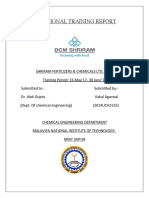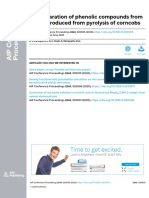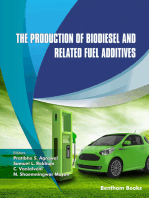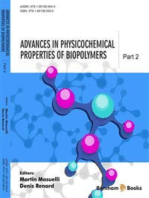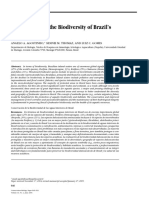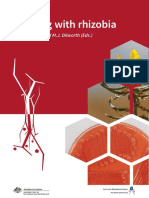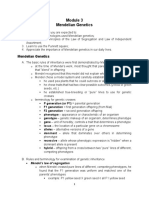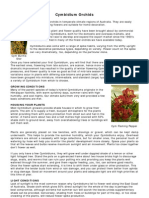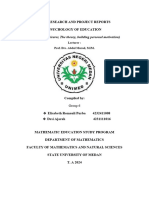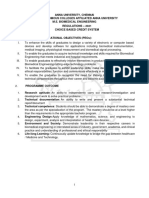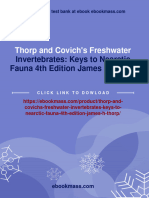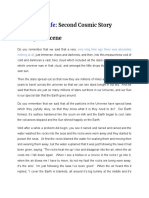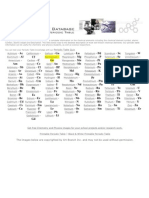FT 3360501
FT 3360501
Uploaded by
Kartik DesaiCopyright:
Available Formats
FT 3360501
FT 3360501
Uploaded by
Kartik DesaiOriginal Description:
Original Title
Copyright
Available Formats
Share this document
Did you find this document useful?
Is this content inappropriate?
Copyright:
Available Formats
FT 3360501
FT 3360501
Uploaded by
Kartik DesaiCopyright:
Available Formats
Fertilizer Technology
Course Code: 3360501
GUJARAT TECHNOLOGICAL UNIVERSITY, AHMEDABAD, GUJARAT
COURSE CURRICULUM
COURSE TITLE: FERTILIZER TECHNOLOGY
(COURSE CODE: 3360501)
Diploma Programme in which this course is offered
Chemical Engineering
Semester in which offered
Sixth
1.
RATIONALE
Indian economy is dominated by agriculture sector. Synthetic fertilizers are must for
producing good crops. Hence it is needed to provide comprehensive and balanced
understanding of essential link between chemistry and the synthetic fertilizer industry. It is
therefore vital for chemical engineers to understand for each fertilizer product, its flow
diagram for Industry production. For this purpose chemical engineers should have skills for
arranging treatment, reaction and separation steps in a flow diagram for variety of fertilizers
including Nitrogenous fertilizers, Phosphatic fertilizer, Potash Fertilizer, Complex fertilizer
and Bio fertilizers is essential. Hence this course is designed to achieve this objective.
2.
COMPETENCY
The course content should be taught and curriculum should be implemented with the aim to
develop required skills in the students so that they are able to acquire the following
competencies:
Supervise the different stages in fertiliser production.
3.
COURSE OUTCOMES (COs)
The theory should be taught and practicals should be carried out in such a manner that
students are able to acquire different learning outcomes in cognitive, psychomotor and
affective domain:
i.
Use reactions and unit operations steps in manufacturing of various fertilizers
ii.
Characterize fertilizers on the basis of different properties.
iii.
Identify engineering problems in fertilizer manufacturing.
iv.
Handle the fertilizers.
v.
Select appropriate synthesis fertilizer.
4.
TEACHING AND EXAMINATION SCHEME
Teaching Scheme
(In Hours)
Total Credits
(L+T+P)
Examination Scheme
Theory
Marks
Practical Marks
ESE
PA
ESE
PA
06
70
30
20
30
Total Marks
150
Legends: L Lecture, T -Tutorial/Teacher Guided Student Activity, P Practical, C Credit, ESE - End
Semester Examination, PA -Progressive Assessment
GTU/NITTTR/Bhopal/14
Gujarat State
1
Fertilizer Technology
5.
Course Code: 3360501
COURSE CONTENT DETAILS
Major Learning Outcomes
Topics and Sub-topics
(In Cognitive Domain)
1a.
Justify
the need for synthetic
1.1 Synthetic fertilizers, Classification
Unit I
fertilizer
of fertilizers
Overview
1b. Categorize fertilizers
1.2 Role of essential Elements in plant
of
Growth,
Fertilizers 1c. Explain role of essential elements
for plant growth
1.3 Macro elements and Micro
elements
1d. Select the relevant fertilizers for
1.4 Application of fertilizers
the different types of crops
considering Nutrient
1.5 Balance and types of crop
Unit
2a. Describe different properties of
Unit II
Ammonia
Nitrogeneo
2b. Prepare synthesis path for
us
manufacturing synthesis gas
Fertilizers
2c. Differentiate various Ammonia
converter
2d. Differentiate various Ammonia
manufacturing process
2e. Describe the engineering
problems of ammonia
manufacturing
2f. Describe various properties of
Nitric Acid
2g. Estimate concentration of Nitric
acid
2h. Describe the problems in
manufacturing of Nitric Acid
2i. Describe various properties of
Urea
2j. Describe the major engineering
problems of Urea Manufacturing
2k. Describe the manufacturing
process of Ammonium Nitrate
GTU/NITTTR/Bhopal/14
2.1 Ammonia: Physical, chemical
properties and applications
2.2 Synthesis gas by Catalytic partial
oxidation Steam Hydrocarbon
reforming
2.3 Ammonia converters: Single bed
and multi-bed converter
2.4 Manufacturing of ammonia by
Linde Ammonia concept process
2.5 M. W. Kellogg process and Haldor
Topsoe process
2.6 Storage and Transportation of
Ammonia
2.7 Nitric acid: Chemical, physical
properties and applications
2.8 Manufacturing of Nitric Acid by
Pressure ammonia oxidation
process and Intermediate pressure
ammonia oxidation process
2.9 Concentration of Nitric acid by
Mg(NO3)2
2.10 Urea : Physical, chemical
properties
2.11 Manufacturing of Urea by
Stamicarbon's CO2 stripping
process, Montecatini Solution
recycle process Toyo-Koatsu total
recycle process
2.12 Manufacturing of Ammonium
nitrate by Prilling process,
Ammonium sulphate from
Ammonium carbonate and gypsum
Ammonium chloride from
Ammonium sulphate and sodium
chloride
Gujarat State
Fertilizer Technology
Unit
3a.
Unit III
Phosphatic
Fertilizer
3b.
3c.
3d.
Course Code: 3360501
Major Learning Outcomes
(In Cognitive Domain)
Describe various physical and
chemical properties Phosphorus
and Phosphoric acid
Describe the manufacturing
process of Phosphorus by Electric
furnace method
Describe the manufacturing
process of phosphoric acid by
Wet Process
Describe the manufacturing
Strong Sulphuric Acid Leaching
Hydrochloric Acid Leaching
Electric Furnace Process
4a. Describe physical and chemical
Unit IV
properties
Potassic
Fertilizers 4b. Explain manufacturing of
Potassium Chloride from
sylvinite
4c. Describe the of Preparation of
Potassium nitrate, Potassium
sulphate
Topics and Sub-topics
3.1 Physical, chemical properties and
applications of Phosphorus and
Phosphoric acid
3.2 Manufacturing of elemental
phosphorous by Electric furnace
method
3.3 Manufacturing phosphoric acid by
Wet Process
3.4 Strong Sulphuric Acid Leaching
Hydrochloric Acid Leaching
Electric Furnace Process
4.1 Physical, chemical properties and
uses of Potassium Chloride,
Potassium nitrate, Potassium
sulphate
4.2 Manufacturing of potassium
chloride from sylvinite
4.3 Preparation of Potassium nitrate,
Potassium sulphate
Unit V
Complex
Fertilizer
and Bio
Fertilizer
5a. Explain the manufacturing of
5.1 Manufacturing of NPK,
complex fertilizers with sketches
Ammonium Sulphate Phosphate
6a. Justify the need for biofertilizers
(ASP), Calcium Ammonium
and its benefits
Nitrate(CAN)
6b. Describe the Nitrogen fixing and 6.1 Types of Biofertilizers
Phosphate solubilising
6.2 Biofertilizers Nitrogen-fixing
biofertilizers
biofertilizers Phosphate6c. Explain preparation a
solubilizing biofertilizers
biofertilizers
6.3 Preparation of a biofertilizers
6.
SUGGESTED SPECIFICATION TABLE WITH HOURS & MARKS (Theory)
Unit
Teaching
Distribution of Theory
Unit Title
No.
Hours
Marks
R
U
A
Total
Level Level Level
Overview of Fertilizers
1
06
02
04
02
08
Nitrogeneous Fertilizers
2
22
06
09
06
21
Phosphatic Fertilizers
3
10
03
06
03
12
Potassic Fertilizers
4
06
03
05
03
11
Complex Fertilizers and Bio Fertilizers
5
12
06
06
06
18
TOTAL
56
20
30
20
70
Legends: R = Remember, U = Understand, A= Apply and above Level (Blooms revised
taxonomy)
GTU/NITTTR/Bhopal/14
Gujarat State
3
Fertilizer Technology
Course Code: 3360501
Note: This specification table shall be treated as a general guideline for students and teachers.
The actual distribution of marks in the question paper may vary slightly from above table.
7.
SUGGESTED PRACTICAL / EXERCISES
The practical/exercises should be properly designed and implemented with an attempt to develop
different types of skills (outcomes in psychomotor and affective domain) so that students are
able to acquire the competencies/programme outcomes. Following is the list of practical
exercises for guidance.
Note: Here only outcomes mainly in psychomotor domain are listed as practical/exercises.
However, if these practical/exercises are completed appropriately, they would also lead to
development of certain outcomes in affective domain which would in turn lead to development
of Course Outcomes related to affective domain. Thus over all development of Programme
Outcomes (as given in a common list at the beginning of curriculum document for this
programme) would be assured.
Faculty should refer to that common list and should ensure that students also acquire outcomes
in affective domain which are required for overall achievement of Programme
Outcomes/Course Outcomes.
S. Unit
No. No.
1
II
II
II
II
7
8
II
II
9
10
11
12
13
14
15
II
III
III
IV
IV
V
V
Practical/Exercise
(Outcomes in Psychomotor Domain)
Prepare chart for fertilizer classification with chemical formula and
nutrient content
Estimate nutrient content (% N, %P2O, % K2O) in different
fertilizers from their chemical formula
Estimate percentage of Nitrogen in Ammonium chloride by
substitution method
Estimate percentage of Nitrogen in Ammonium sulfate by
substitution method
Estimate percentage of Nitrogen in Ammonium chloride by back
titration
Estimate percentage of Nitrogen in Ammonium sulphate by back
titration
Analysis of Urea by Formaldehyde method
Estimate percentage of Nitrogen in Ammonium Chloride/Sulphate
by Kjeldhal's method
Estimate biuret content in Urea sample by colour comparison
Estimate percentage of Nitrogen in DAP by Formaldehyde method
Estimate percentage of Nitrogen in DAP by Kjeldhal's method
Prepare potassium sulphate
Prepare potasium chloride
Estimate ratio from Ammonia to Phosphoric acid in DAP
Prepare potassium nitrate
GTU/NITTTR/Bhopal/14
Approx.
Hours
Required
02
02
02
02
02
02
02
02
02
02
02
02
02
02
02
Gujarat State
Fertilizer Technology
S. Unit
No. No.
16
VI
Course Code: 3360501
Practical/Exercise
(Outcomes in Psychomotor Domain)
Prepare bio-fertilizer
Total
Approx.
Hours
Required
02
32
8.
SUGGESTED STUDENT ACTIVITIES
Following is the list of proposed student activities. These could be individual or group-based.
i. Prepare course/topic based presentations using internet
ii. Make a report on fertiliser plants in India/Gujarat with their capacity of production
and technology being used.
iii. Participate in MCQ/Quiz.
9.
i.
ii.
iii.
iv.
10.
SPECIAL INSTRUCTIONAL STRATEGY (IF ANY)
Show video/animation films about fertilizer production plants.
Arrange Visit to nearby fertilizer production plant
Arrange expert lectures
Arrange MCQ/Quiz arrange in normal term period.
SUGGESTED LEARNING RESOURCES
A)
Books
Title of Book
S. No.
1
Dryden's Outlines of
Chemical Technology,
2
Shreves Chemical Process
Industries, 5th edition
3
Chemical Technology
-Vol. I and II, 2nd edition
4
B)
i.
ii.
iii.
iv.
v.
vi.
Biofertilizers in Agriculture,
2nd edition
Author
M. Gopala Rao
Sitting Marshall
Austin G.T.
Pandey G.N. and
Shukla
N. S. Subba Rao
Publication
Affiliated East West Press
(Pvt) Ltd, 3rd Ed., New Delhi
McGraw Hill publication, New
Delhi
Vani Books Company
- Hyderabad
Oxford & IBH Publishing
Company, New Delhi 1988
Major Equipment / Instrument with Broad Specifications
Glassware: Conical flask, burette, pipette, RBF, measuring cylinder, beaker
Glass Assembly: RBF, reaction vessel, condenser, separating vessel
Burner
Weight balance (minimum 0.1gm)
Heating and cooling bath
Kjeldhal Assembly
C)
i.
ii.
iii.
iv.
v.
vi.
Software/Learning Websites
http://nptel.ac.in/courses/103107086/4
http://ijset.com/ijset/publication/v1s6/285-291%20IJSET_PK%20JAGA.pdf
www.gses.com/images/pressreleases/Manufacturing-Process-Fertilizer.pdf
http://nzic.org.nz/ChemProcesses/production/1A.pdf
http://tnau.ac.in/eagri/eagri50/SSAC222/lec12.pdf
www.fnca.mext.go.jp/bf/bfm/pdf/Biofertilizer_Manual.pdf
11.
COURSE CURRICULUM DEVELOPMENT COMMITTEE
GTU/NITTTR/Bhopal/14
Gujarat State
5
Fertilizer Technology
Course Code: 3360501
Faculty Members from Polytechnics
Prof. N. N. Hansalia, Lecturer in Chemical Engineering, Government
Rajkot
Prof. R. P. Hadiya, Lecturer in Chemical Engineering, Government
Rajkot
Prof.Rakesh R Vasava, Lecturer in Chemical Engineering, Shri K. J.
Bharuch
Prof. M. R. Aacharya, Lecturer in Chemical Engineering, Government
Gandhinagar
Polytechnic,
Polytechnic,
Polytechnic,
Polytechnic,
Coordinator andFaculty Members from NITTTR Bhopal
Dr. Abhilash Thakur. Associate Professor, Department of Applied Sciences
Dr. Joshua Earnest, Professor, Department of Electrical & Electronics Engineering.
GTU/NITTTR/Bhopal/14
Gujarat State
6
You might also like
- Chemical Pathology Questions For DiplomaDocument11 pagesChemical Pathology Questions For DiplomaSAMMY67% (3)
- Anxiety FreeDocument20 pagesAnxiety FreeOana Iacob100% (2)
- Project Report at Cumene PDFDocument103 pagesProject Report at Cumene PDFDiv Savaliya100% (2)
- Cumene Project ReportsDocument42 pagesCumene Project ReportsDiv Savaliya100% (3)
- Rubric For Human Impact ProjectDocument2 pagesRubric For Human Impact ProjectJohn OsborneNo ratings yet
- Fertilizer TechDocument3 pagesFertilizer TechNeel ShelatNo ratings yet
- Fertilizer TechnologyDocument3 pagesFertilizer Technology2020001873.gcetNo ratings yet
- Fertilizer TechnologyDocument6 pagesFertilizer TechnologySehjad khan BalochNo ratings yet
- CHE-0905554 Fertilizers Technology-Sep-2014-FallDocument4 pagesCHE-0905554 Fertilizers Technology-Sep-2014-FalllaminarsNo ratings yet
- Jeevika DOCU 46Document199 pagesJeevika DOCU 46Anuj Kumar0% (1)
- CPI - Course DescriptiveDocument5 pagesCPI - Course Descriptiverohithelango328No ratings yet
- Semester-V: 2. CompetencyDocument8 pagesSemester-V: 2. CompetencyCliches inNo ratings yet
- 1601 - Indus Chem Lab ManualDocument46 pages1601 - Indus Chem Lab ManualChristy Joy Retanal100% (1)
- Latest Edited 1 PDFDocument95 pagesLatest Edited 1 PDFDiv SavaliyaNo ratings yet
- Chemical Process TechnologyDocument9 pagesChemical Process TechnologyRITZCOOL FOR YOUNo ratings yet
- Reactor Design For PetrochemicalDocument40 pagesReactor Design For Petrochemicalsinwei93No ratings yet
- 2017CHE003 FinalPaper Draft 8 1Document90 pages2017CHE003 FinalPaper Draft 8 1Evan DulayNo ratings yet
- Microbial Sensing in FermentationFrom EverandMicrobial Sensing in FermentationSatinder K. BrarNo ratings yet
- Production of L-Glutamic Acid Using Submerged and Solid-State Fermentations by Utilizing Agro - Industrial WastesDocument15 pagesProduction of L-Glutamic Acid Using Submerged and Solid-State Fermentations by Utilizing Agro - Industrial WastesImmanuelrajNo ratings yet
- Physico-Chemical Characterisation of Sesame Seeds in NigeriaDocument19 pagesPhysico-Chemical Characterisation of Sesame Seeds in NigeriaefosaaigbolosumuaNo ratings yet
- Baking PowderDocument25 pagesBaking Powderbig johnNo ratings yet
- SyllabusDocument6 pagesSyllabusAbhishek Gond100% (1)
- Isi Kandungan SinaDocument1 pageIsi Kandungan SinaMohd HafiezNo ratings yet
- Production of 20 000 MTPD of Methyl Tertiary Butyl Ether From Methanol and Butylenes by Catalytic ConversionDocument177 pagesProduction of 20 000 MTPD of Methyl Tertiary Butyl Ether From Methanol and Butylenes by Catalytic ConversioniffatNo ratings yet
- Dissertation OutlineDocument2 pagesDissertation OutlineweiwenNo ratings yet
- Resume: Professional ObjectiveDocument3 pagesResume: Professional ObjectivepratikNo ratings yet
- Report On NFLDocument38 pagesReport On NFLanand DoliaNo ratings yet
- FTE 22615 Unit Test-1 QB_110120Document2 pagesFTE 22615 Unit Test-1 QB_110120shri sankaplNo ratings yet
- Malathion 2013Document80 pagesMalathion 2013Arifin R HidayatNo ratings yet
- 2019-08-26 Doktorarbeit Katja ZornDocument137 pages2019-08-26 Doktorarbeit Katja ZornProsie VNo ratings yet
- FPNB 19Document220 pagesFPNB 19Viktoria VonaNo ratings yet
- D4.3 A Downstream Processing Protocol of Enzymes PurificationDocument6 pagesD4.3 A Downstream Processing Protocol of Enzymes PurificationUyen HuynhNo ratings yet
- 19ag423 - Bio-Energy System Design and ApplicationsDocument4 pages19ag423 - Bio-Energy System Design and Applicationsdevdixit1915No ratings yet
- 3360508Document5 pages3360508DivyamNo ratings yet
- Phulpur Unit AkkiDocument29 pagesPhulpur Unit AkkiGaming ChemistNo ratings yet
- Ajeet Singh Iffco ReportDocument53 pagesAjeet Singh Iffco ReportNaveen DikshitNo ratings yet
- 6.13 R T.Y.B.sc. Applied Components Patrochemicals Sem v VIDocument15 pages6.13 R T.Y.B.sc. Applied Components Patrochemicals Sem v VIgamingbroken2004No ratings yet
- Imidacloprid 08Document41 pagesImidacloprid 08kittyhawk88No ratings yet
- Bioresource Technology: Sumit Kumar, Neerja Yadav, Lata Nain, Sunil Kumar KhareDocument4 pagesBioresource Technology: Sumit Kumar, Neerja Yadav, Lata Nain, Sunil Kumar KhareJosé BeltránNo ratings yet
- Fao Specifications and Evaluations For Agricultural PesticidesDocument44 pagesFao Specifications and Evaluations For Agricultural Pesticidesivanjose09No ratings yet
- Ag Report UreaDocument40 pagesAg Report UreaVakul AgarwalNo ratings yet
- V SEM PHCOG & PHYTO II Question Bank - ReferenceDocument25 pagesV SEM PHCOG & PHYTO II Question Bank - ReferenceManasaNo ratings yet
- FermentationDocument20 pagesFermentationZulkapliSolandNo ratings yet
- Chemical Engineering 051Document23 pagesChemical Engineering 051Malani PankajNo ratings yet
- Chem ProjectDocument14 pagesChem Projectriddhiii2861No ratings yet
- The Separation of Phenolic Compounds From Bio-Oil Produced From Pyrolysis of CorncobsDocument9 pagesThe Separation of Phenolic Compounds From Bio-Oil Produced From Pyrolysis of CorncobsBundanufa CiciNo ratings yet
- HandDocument3 pagesHandTIRTH ANAND TRIVEDINo ratings yet
- NMR020008 1 5.0111708Document10 pagesNMR020008 1 5.0111708Sahri YantiNo ratings yet
- Production of Phosphoric AcidDocument48 pagesProduction of Phosphoric Acidche_abdo75% (4)
- Project Report On NPK Fertilizer in Granule FormDocument8 pagesProject Report On NPK Fertilizer in Granule FormEIRI Board of Consultants and PublishersNo ratings yet
- Ribeiro-Filho 2022. The Role of Inorganic-Phosphate, Potassium and Magnesium in Yeast-Flavour Formation.Document10 pagesRibeiro-Filho 2022. The Role of Inorganic-Phosphate, Potassium and Magnesium in Yeast-Flavour Formation.Florencia GorordoNo ratings yet
- Final PDFDocument96 pagesFinal PDFAbhinav GuptaNo ratings yet
- Alagappa University, Karaikudi Syllabus Under Cbcs Pattern (W.E.F 2011-12) B.SC., Bio-Chemistry - Programme StructureDocument23 pagesAlagappa University, Karaikudi Syllabus Under Cbcs Pattern (W.E.F 2011-12) B.SC., Bio-Chemistry - Programme StructureMathan NaganNo ratings yet
- Unit ProcessDocument4 pagesUnit ProcessDhwanikNo ratings yet
- Iffco ReportDocument22 pagesIffco ReportNEHANo ratings yet
- Food Processing By-Products and their UtilizationFrom EverandFood Processing By-Products and their UtilizationAnil Kumar AnalNo ratings yet
- Fchem 10 944398Document10 pagesFchem 10 944398Andres Mauricio Hernandez GarciaNo ratings yet
- Principles and Applications of Fermentation TechnologyFrom EverandPrinciples and Applications of Fermentation TechnologyArindam KuilaNo ratings yet
- New Polymers for Encapsulation of Nutraceutical CompoundsFrom EverandNew Polymers for Encapsulation of Nutraceutical CompoundsJorge Carlos Ruiz RuizNo ratings yet
- Advances in Physicochemical Properties of Biopolymers: Part 2From EverandAdvances in Physicochemical Properties of Biopolymers: Part 2No ratings yet
- Emerging Areas in BioengineeringFrom EverandEmerging Areas in BioengineeringHo Nam ChangNo ratings yet
- Teacher & School DetailDocument1 pageTeacher & School DetailKartik Desai100% (1)
- 3350503Document2 pages3350503Kartik Desai100% (1)
- Chapter 4 PDFDocument24 pagesChapter 4 PDFMd. Badrul IslamNo ratings yet
- Jivan Samruddhi June 2018Document1 pageJivan Samruddhi June 2018Kartik DesaiNo ratings yet
- GATE 2017 Admit Card: Instructions To The CandidateDocument1 pageGATE 2017 Admit Card: Instructions To The CandidateKartik DesaiNo ratings yet
- 3350501Document5 pages3350501Kartik DesaiNo ratings yet
- Enggquest 2012: N. G. Patel PolytechnicDocument1 pageEnggquest 2012: N. G. Patel PolytechnicKartik DesaiNo ratings yet
- Chapter-1 Intro & Properties of Particulate SolidsDocument11 pagesChapter-1 Intro & Properties of Particulate SolidsKartik DesaiNo ratings yet
- Chapter 8 MixingDocument20 pagesChapter 8 MixingKartik DesaiNo ratings yet
- 5.2 Curriculam RelevanceDocument1 page5.2 Curriculam RelevanceKartik DesaiNo ratings yet
- Enggquest 2012: Who Is Popularly Known As 'Father of Indian Constitution'?Document15 pagesEnggquest 2012: Who Is Popularly Known As 'Father of Indian Constitution'?Kartik DesaiNo ratings yet
- Longman's Encyclopedia - ReptilesDocument40 pagesLongman's Encyclopedia - Reptilesrengachen100% (8)
- Paranjay Practice of ComputerDocument2 pagesParanjay Practice of ComputerKartik DesaiNo ratings yet
- EPA FadsorbDocument32 pagesEPA FadsorbNupur BaliNo ratings yet
- ContentDocument3 pagesContentKartik DesaiNo ratings yet
- Course Code: 157 Course Name: Applied Science-I (Physics)Document10 pagesCourse Code: 157 Course Name: Applied Science-I (Physics)Kartik DesaiNo ratings yet
- Gujarat Technological University, Ahmedabad.: Engineering Measurements - IDocument2 pagesGujarat Technological University, Ahmedabad.: Engineering Measurements - IKartik DesaiNo ratings yet
- Cell Structures and FunctionsDocument2 pagesCell Structures and FunctionsWallen LagradaNo ratings yet
- Ecological Relationship: Oppositional RelationshipsDocument7 pagesEcological Relationship: Oppositional Relationshipsjeanette PradesNo ratings yet
- Child Development NodrmDocument310 pagesChild Development Nodrmasal.alimardani80No ratings yet
- Conservation Biology - 2005 - AGOSTINHO - Conservation of The Biodiversity of Brazil S Inland WatersDocument7 pagesConservation Biology - 2005 - AGOSTINHO - Conservation of The Biodiversity of Brazil S Inland WatersStefani CamposNo ratings yet
- ID Improvement in Number and Quality ProducDocument12 pagesID Improvement in Number and Quality ProducYolla sundaeiNo ratings yet
- Lysing Solution Iotest 3: 10X ConcentrateDocument3 pagesLysing Solution Iotest 3: 10X ConcentrateabubakerNo ratings yet
- Ecology PacketDocument47 pagesEcology Packetsabbate1994No ratings yet
- Working With RhizobiaDocument314 pagesWorking With RhizobialucasgirioNo ratings yet
- Antibiotic Selection Guide PosterDocument1 pageAntibiotic Selection Guide PosterjbenedicNo ratings yet
- Module 3 Mendelian GeneticsDocument14 pagesModule 3 Mendelian GeneticsRaiza AwatNo ratings yet
- Chapter 2 Bio461Document36 pagesChapter 2 Bio461NURUL AIHAN AHMAD HILMINo ratings yet
- Module 5 - POPULATION DYNAMICS - JULY 12 Student GuideDocument10 pagesModule 5 - POPULATION DYNAMICS - JULY 12 Student GuideAbi NeriNo ratings yet
- Species Composition, Commercial Landings, Distribution and Some Aspects of Biology of Shark (Class Pisces) of Pakistan Mediumsized Demersal SharksDocument23 pagesSpecies Composition, Commercial Landings, Distribution and Some Aspects of Biology of Shark (Class Pisces) of Pakistan Mediumsized Demersal SharksaleshbahjamilNo ratings yet
- Cymbidium OrchidsDocument3 pagesCymbidium Orchidsdun_aromatixNo ratings yet
- Mini Research and Project Reports 4Document17 pagesMini Research and Project Reports 4desi AzhraNo ratings yet
- FLGX113 SU3.1 and SU 3.2Document48 pagesFLGX113 SU3.1 and SU 3.2Jason Van Den HeeverNo ratings yet
- The Digestive SystemDocument2 pagesThe Digestive SystemJohn Rex VillanuevaNo ratings yet
- Biology 2 PucDocument23 pagesBiology 2 PucTULASI BAINo ratings yet
- Araga Tate Niversity: What Happens During Learning? Brain and Behavior ChangesDocument26 pagesAraga Tate Niversity: What Happens During Learning? Brain and Behavior ChangesKiethNo ratings yet
- Kingdom ProtistaDocument3 pagesKingdom Protistabasumatijal13No ratings yet
- ME. Biomedical Engineering REG 2021Document61 pagesME. Biomedical Engineering REG 2021Sangeetha TharmarNo ratings yet
- Get Thorp and Covich's Freshwater Invertebrates: Keys To Nearctic Fauna 4th Edition James H. Thorp Free All ChaptersDocument64 pagesGet Thorp and Covich's Freshwater Invertebrates: Keys To Nearctic Fauna 4th Edition James H. Thorp Free All Chaptersbalcanfokker100% (5)
- Coming of Life - Second Cosmic StoryDocument7 pagesComing of Life - Second Cosmic Storyelena_vcNo ratings yet
- Animals With Sounds PDFDocument3 pagesAnimals With Sounds PDFabdulmejidjemal1No ratings yet
- Periodic TableDocument3 pagesPeriodic Tablenada_izyanNo ratings yet
- (Biology) Class XII Question BankDocument3 pages(Biology) Class XII Question Bankn6678720No ratings yet
- Scientific Research MeditationDocument5 pagesScientific Research MeditationRealWellness.netNo ratings yet









































